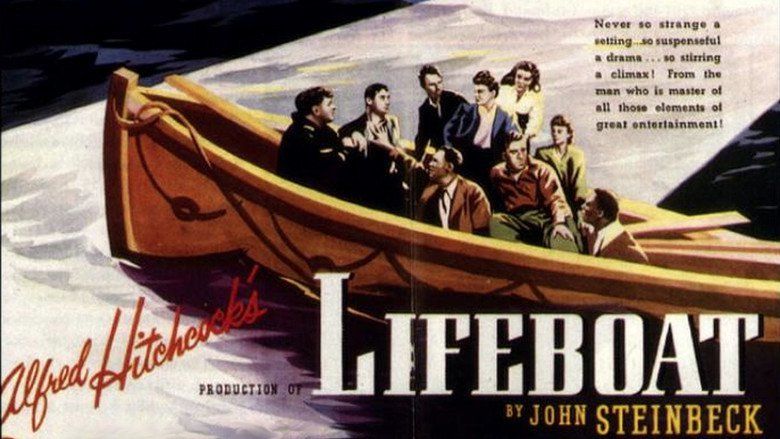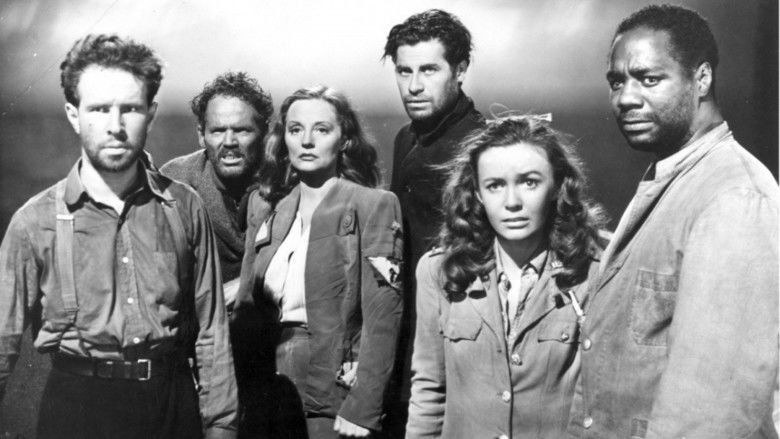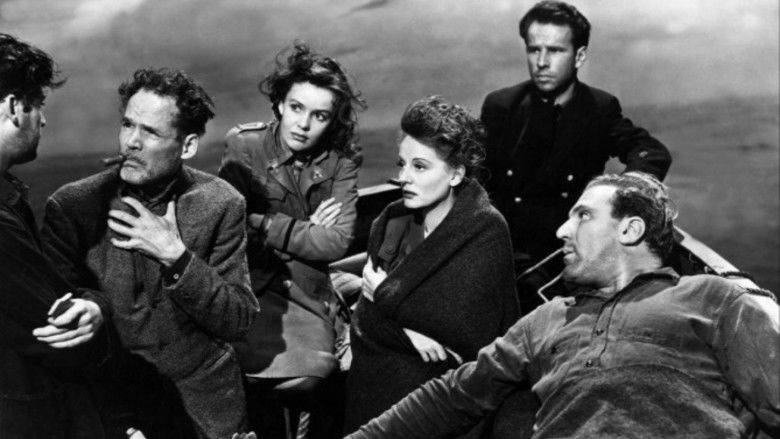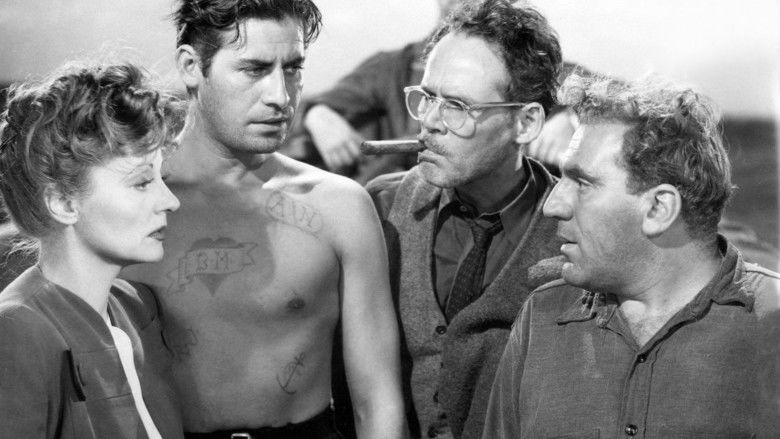Lifeboat (film)
8.6 /10 1 Votes
95% Rotten Tomatoes Genre Thriller, War Duration Language English | 7.8/10 IMDb Director Alfred Hitchcock Initial DVD release October 18, 2005 Country United States | |||||||||||||||||||||||||||||||||
 | ||||||||||||||||||||||||||||||||||
Release date January 11, 1944 (1944-01-11) (U.S.) Writer John Steinbeck (by), Jo Swerling (screen play) Screenplay John Steinbeck, Jo Swerling, Ben Hecht Cast Tallulah Bankhead (Connie Porter), William Bendix (Gus), Walter Slezak (Willy), Mary Anderson (Alice MacKenzie), John Hodiak (Kovac), Henry Hull (Rittenhouse)Similar movies Related Alfred Hitchcock movies Tagline Six men and three women - against the sea, and each other! | ||||||||||||||||||||||||||||||||||
Lifeboat is a 1944 American survival thriller drama film directed by Alfred Hitchcock from a story by John Steinbeck. The film stars Tallulah Bankhead with William Bendix. Also in the cast are Walter Slezak, Mary Anderson and John Hodiak. Additional roles in the boat were from Henry Hull, Heather Angel, Hume Cronyn, and Canada Lee. It is set entirely on a lifeboat launched from a sinking passenger vessel following a World War II naval attack.
Contents

The film is the first in Hitchcock's "limited-setting" films, the others being Rope (1948), Dial M for Murder (1954), and Rear Window (1954). It is the only film Hitchcock made for 20th Century Fox. The film received Academy Award nominations for Best Director, Best Original Story and Best Cinematography – Black and White. Tallulah Bankhead won the New York Film Critics Circle award for best actress of the year. Though highly controversial in its time for what many interpreted as its sympathetic depiction of a German U-boat captain, Lifeboat is now viewed more favorably and has been listed by several modern critics as one of Hitchcock's most underrated films.

Plot

Several British and American civilians, service members and merchant mariners are stuck in a lifeboat in the North Atlantic after their ship and a U-boat sink each other in combat. Willi (Walter Slezak), a German survivor, is pulled aboard and denies being the U-boat's captain. During an animated debate, engine room crewman Kovac (John Hodiak) demands the German be thrown out to drown. However, the others object, with radioman Stanley (Hume Cronyn), wealthy industrialist Rittenhouse (Henry Hull) and columnist Connie Porter (Tallulah Bankhead), who speaks German, succeeding in arguing that he be allowed to stay. Porter, initially alone in the boat, had managed to bring her luggage with her, and her primary concern at first is a run in her stocking. She is thrilled at having filmed the battle between the two vessels, but her movie camera is the first in a series of her possessions to be lost overboard in a succession of incidents.

Among the passengers is Mrs. Higley, a young British woman (Heather Angel) whose infant child is dead when they are pulled from the water after being saved by steward "Joe" Spencer (Canada Lee). After being treated by a U.S. Army nurse, Alice (Mary Anderson), she must be tied down to stop her from hurting herself. The woman, still wrapped in Porter's mink coat for warmth, sneaks off the boat while the other passengers sleep, drowning herself in the night. Willi is revealed to be the U-boat captain.

The film then follows the lifeboat inhabitants as they attempt to organize their rations, set a course for Bermuda, and coexist as they try to survive. The characters start out being good-natured, cooperative, and optimistic about rescue. However, they descend into desperation, dehydration, and frustration with each other. The back stories of the characters are examined, and divisions of race, religion, sex, class, and nationality are brought to the surface. The passengers also cooperate through this stress, such as when they must amputate the leg of one of their boatmates, the German-American Gus Smith (William Bendix), because of gangrene.

Kovac takes charge, rationing the little food and water they have, but Willi, who has been consulting a concealed compass and reveals that he speaks English, wrests control away from him in a storm. One morning, while the others are sleeping, Smith, who had resorted to drinking seawater, catches Willi drinking water from a hidden flask. Too delirious to be taken seriously by the drowsing survivors, Gus is coaxed overboard by Willi and drowns. Upon waking, the others discover Gus missing and Willi is questioned. When they notice that the German is sweating, the other passengers discover the hoarded flask in his jacket. In a spasm of anger led by Alice, they descend upon him as a group, beat him, and throw him overboard. Rittenhouse strikes him multiple times with Gus' boot to prevent him from re-boarding and, utterly disillusioned by Willi's behavior, laments, "What do you do with people like that?"
The survivors are subsequently spotted by the German supply ship to which Willi had been steering them. Before a launch can pick them up, both it and the supply ship are sunk by gunfire from an Allied warship over the horizon. A frightened young German seaman is pulled aboard the lifeboat. The surviving passengers debate whether to keep him aboard or throw him off to drown as they await rescue by an approaching Allied vessel. The German sailor pulls a gun on the boat occupants but is disarmed by Joe. The seaman asks in German, "Aren't you going to kill me?" Kovac muses, "'Aren't you going to kill me?' What do you do with people like that?"
Cast
Cast notes
Production
At the time that Lifeboat went into production, Alfred Hitchcock was under contract to David O. Selznick. 20th Century Fox obtained the director's services in exchange for that of several actors and technicians, as well as the rights to three stories that Fox owned. Hitchcock was to direct two films for the studio, but the second was never made, apparently because Fox was unhappy with the length of time taken to finish production on Lifeboat.
It was Hitchcock who came up with the idea for the film. He approached A.J. Cronin, James Hilton and Ernest Hemingway to help write the script, before giving the project to John Steinbeck, who had previously written the screenplay for the 1941 documentary The Forgotten Village but had not written a fictional story for the screen. It was Steinbeck's intention to write and publish a novel and sell the rights to the studio, but the story was never published, as his literary agents considered it "inferior". Steinbeck received $50,000 ($733,000 today) for the rights to his story. Steinbeck was unhappy with the film because it presented what he considered to be "slurs against organized labor" and a "stock comedy Negro" when his story had a "Negro of dignity, purpose and personality". He requested, unsuccessfully, that his name be removed from the credits. When a condensed version of the film story appeared in Collier's magazine on November 13, 1942, it was credited to Hitchcock and writer Harry Sylvester, with Steinbeck credited with the "original screen story". Other writers who worked on various drafts of the script include Hitchcock's wife Alma Reville, MacKinlay Kantor, Patricia Collinge, Albert Mannheimer and Marian Spitzer. Hitchcock also brought in Ben Hecht to rewrite the ending.
Lifeboat was originally planned to be filmed in Technicolor with an all-male cast, many of whom were going to be unknowns. Canada Lee, who was primarily a stage actor with only one film credit at the time, was the first actor cast in the film.
Hitchcock planned the camera angles for the film using a miniature lifeboat and figurines. Four lifeboats were used during shooting. Rehearsals took place in one, separate boats were used for close-ups and long shots and another was in the studio's large-scale tank, where water shots were made. Except for background footage shot by the second unit around Miami, in the Florida Keys and on San Miguel Island in California, the film was shot in the 20th Century Fox studio on Pico Boulevard in what is now Century City.
Lifeboat was in production from August 3 through November 17, 1943. Illnesses were a constant part of the production from the beginning. Before shooting began, William Bendix replaced actor Murray Alper when Alper became ill and after two weeks of shooting, director of photography Arthur Miller was replaced by Glen MacWilliams because of illness. Tallulah Bankhead came down with pneumonia twice during shooting and Mary Anderson became seriously ill during production, causing several days of production time to be lost. Hume Cronyn suffered two cracked ribs and nearly drowned when he was caught under a water-activator making waves for a storm scene. He was saved by a lifeguard.
The film is unique among Hitchcock's American films for having no musical score during the narrative (apart from the singing of the U-boat captain, accompanied by flute); the Fox studio orchestra was only used for the opening and closing credits. Hitchcock dismissed the idea of having music in a film about people stranded at sea by asking, "Where would the orchestra come from?" Hugo Friedhofer is said to have asked in reply, "Where would the cameras come from?"
Cameo
Director Alfred Hitchcock made cameo appearances in most of his films. He once commented to François Truffaut – in Hitchcock/Truffaut (Simon and Schuster, 1967) – that this particular cameo was difficult to achieve, due to the lack of passers-by in the film. While having originally considered posing as a body floating past the lifeboat – which he later considered for his cameo in Frenzy – after his success with weight loss, Hitchcock decided to pose for "before" and "after" photos for an advertisement for a fictional weight-loss drug, "Reduco", shown in a newspaper which was in the boat. Supposedly, he later received letters from people asking about Reduco, which he used again in Rope, where Hitchcock's profile and Reduco appear on a red neon sign. The Lifeboat cameo appears 24 minutes into the film.
Response
While modern critics see the film positively, Lifeboat's portrayal of a German character in what was perceived as a positive fashion caused considerable controversy at the time of its release, during the height of World War Two. Influential reviewers and columnists including Dorothy Thompson and Bosley Crowther of The New York Times saw the film as denigrating the American and British characters while glorifying the German. Crowther wrote that "the Nazis, with some cutting here and there, could turn Lifeboat into a whiplash against the 'decadent democracies.' And it is questionable whether such a picture, with such a theme, is judicious at this time." In Truffaut's 1967 book-length interview Hitchcock/Truffaut, Hitchcock paraphrased Thompson's criticism as "Dorothy Thompson gave the film ten days to get out of town."
Such commentary caused Steinbeck, who had previously been criticized because of his handling of German characters in The Moon Is Down, to publicly dissociate himself from the film, to denounce Hitchcock and Swerling's treatment of his material, and to request that his name not be used by Fox in connection with the presentation of the film. Crowther responded by detailing the differences between Steinbeck's novella and the film as released, accusing the film's creators of "pre-empting" Steinbeck's "creative authority".
Hitchcock responded to the criticism by explaining that the film's moral was that the Allies needed to stop bickering and work together to win the war, and he defended the portrayal of the German character, saying, "I always respect my villain, build[ing] him into a redoubtable character that will make my hero or thesis more admirable in defeating him or it." Bankhead backed him up in an interview in which she said that the director "wanted to teach an important lesson. He wanted to say that you can't trust the enemy... in Lifeboat you see clearly that you can't trust a Nazi, no matter how nice he seems to be."
Tallulah Bankhead called the criticism leveled at the film that it was too pro-Axis "moronic".
Criticism was also leveled at the script for its portrayal of the African-American character Joe as "too stereotypical". Actor Canada Lee testified that he had attempted to round out the character by revising dialogue, primarily eliminating repeated "yessir"s and "nossir"s that sounded subservient, and cutting some actions. The overseas section of the Office of War Information's Bureau of Motion Pictures reviewed the picture and for these and other racial characterizations recommended that Lifeboat not be distributed overseas. An NAACP critique of the film condemned Lee's role unequivocally although praising his performance. However the Baltimore Afro-American's review, while commenting on shortcomings regarding the character, praised both the performance and its role depiction. Historian Rebecca Sklaroff, while writing that Joe's role was more "tokenistic" than black roles in the wartime films Sahara and Bataan, noted that Joe was also depicted as compassionate, dependable and heroic, the only cast member stepping forward to disarm the second German sailor rescued.
Critics praised the film's acting, directing, and cinematography and noted with appreciation the lack of background music once the film proper begins. Still, studio executives, under pressure because of the controversies, decided to give the film a limited release instead of the wide release most of Hitchcock's films received. Advertising for the film was also reduced, which resulted in the film's poor box office showing when it was released in 1944.
Adaptations
NBC broadcast a one-hour radio adaptation of the film on Screen Directors Playhouse on November 16, 1950. Hitchcock directed, and Bankhead reprised her role from the film. The cast also featured Jeff Chandler and Sheldon Leonard.
In 1993, Lifeboat was remade as a science fiction TV movie under the title Lifepod. Moving the action from a lifeboat to a spaceship's escape capsule in the year 2169, the remake starred Ron Silver, who also directed, Robert Loggia, and CCH Pounder. The film was aired on the Fox Broadcasting Company channel in the United States. The film credited Hitchcock and Harry Sylvester for the story.
References
Lifeboat (film) WikipediaLifeboat (film) IMDbLifeboat (film) Rotten TomatoesLifeboat (film) themoviedb.org
